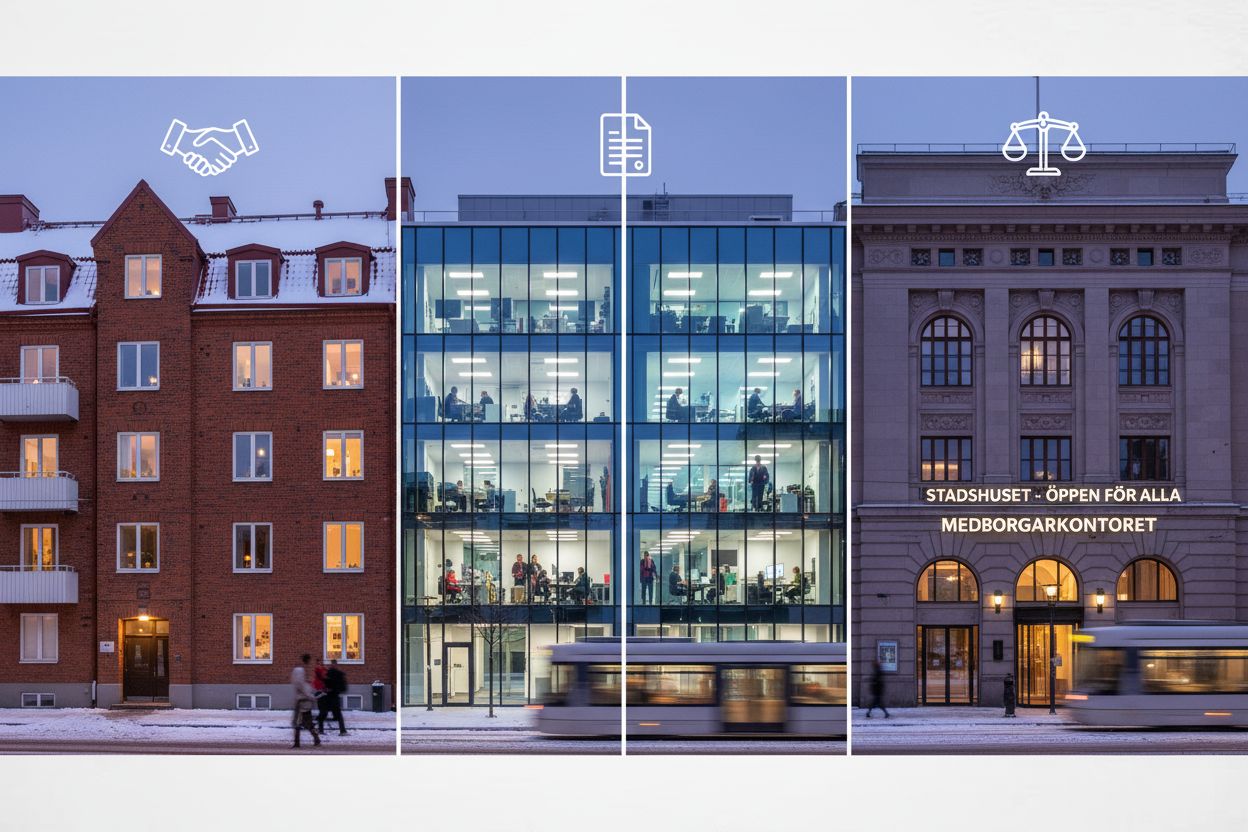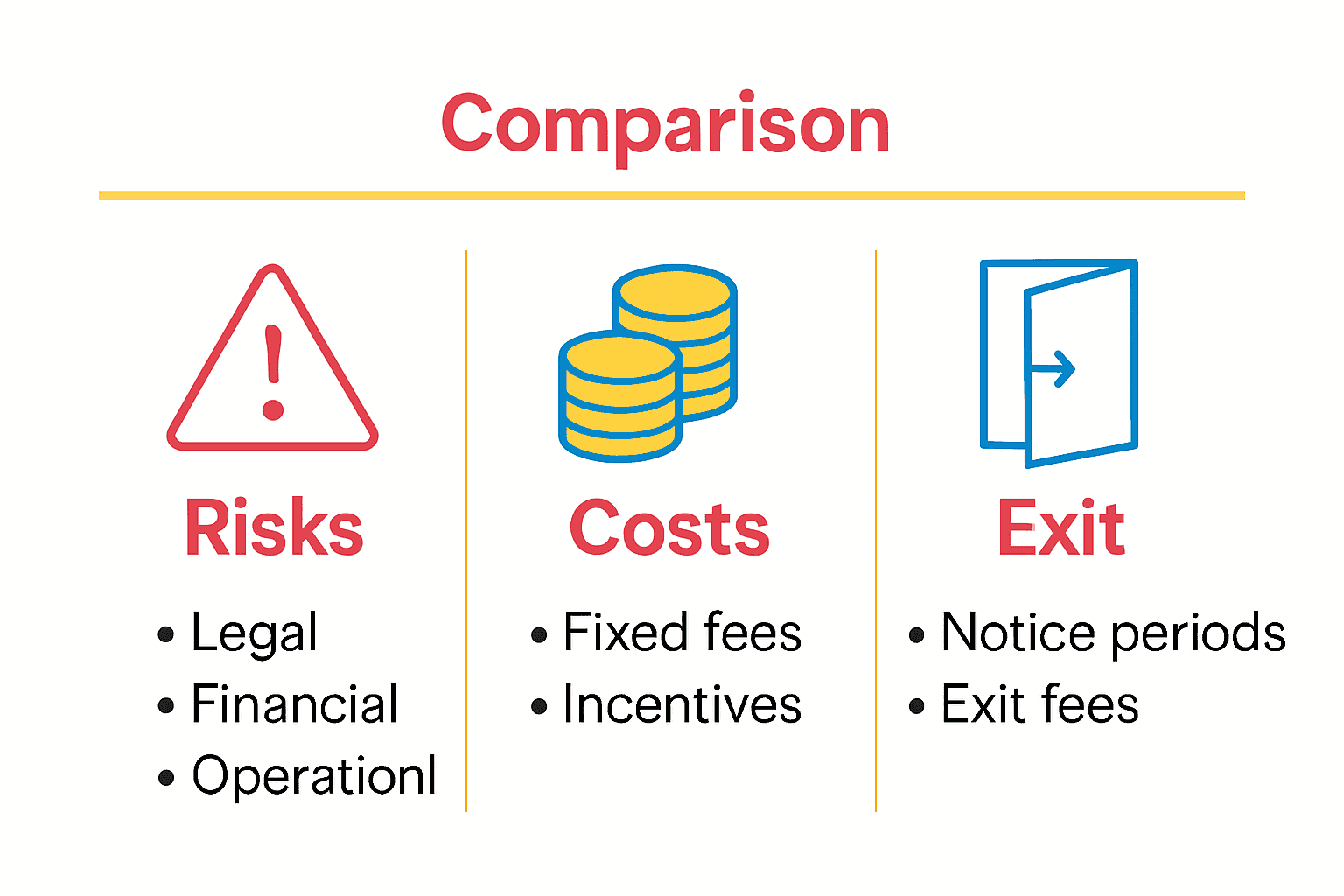Nearly 80 percent of property owners in Sweden use professional management services to oversee their real estate. A clear property management agreement can make the difference between smooth operations and costly misunderstandings. Knowing how these agreements work empowers owners to delegate confidently, establish accountability, and protect their investments from legal and financial risks.
Table of Contents
- Defining A Property Management Agreement
- Types Of Property Management Agreements In Sweden
- Core Clauses And Operational Features
- Legal Framework And Owner Protections
- Risks, Costs, And Exit Procedures
Key Takeaways
| Point | Details |
|---|---|
| Property Management Agreement Definition | A legally binding contract that clarifies the relationship between property owners and management services, specifying responsibilities and compensation terms. |
| Types of Agreements in Sweden | Varies by property type, with distinct management focuses for residential, commercial, and public real estate sectors. |
| Core Clauses Importance | Essential clauses establish a structured operational framework, including service scope, remuneration, and owner approval mechanisms. |
| Legal Protections for Owners | Swedish regulations provide robust safeguards, ensuring compliance, minimizing risks, and outlining dispute resolution processes for property owners. |
Defining a Property Management Agreement
A Property Management Agreement is a legally binding contract that establishes the professional relationship between a property owner and a property management service. According to Bremer Whyte, this agreement comprehensively outlines the manager’s responsibilities, the precise scope of services provided, and the specific terms of compensation.
The agreement serves as a critical document that creates clarity and structure in the professional engagement. As research from Hoogells indicates, it typically specifies several key elements:
- The method and timing of property handover
- Detailed scope of management services
- Provisions for remuneration
- Provisions for additional management activities
At its core, a property management agreement protects both parties by establishing clear expectations. For property owners, it provides a structured approach to delegating property oversight, while for property managers, it defines the boundaries and parameters of their professional responsibilities. The document acts as a roadmap, ensuring transparent communication, defining performance metrics, and establishing a framework for potential dispute resolution.
Types of Property Management Agreements in Sweden
In Sweden, property management agreements are nuanced and vary significantly across different property sectors. According to research from Workers Stay, these agreements fundamentally differ based on the type of property being managed, with distinct practices emerging for residential, commercial, and public real estate segments.
The Swedish property management landscape typically encompasses three primary agreement types:
Here’s a comparison of the main types of property management agreements in Sweden:
| Agreement Type | Property Examples | Key Management Focus |
|---|---|---|
| Residential | Flats Condominiums Housing complexes |
Tenant relations Maintenance Rent collection |
| Commercial | Offices Retail units Business parks |
Leasing Facility management Legal compliance |
| Public Real Estate | Municipal housing Government buildings Social housing |
Social responsibility Cost-based rent Regulatory reporting |
- Residential Property Management: Focused on managing private apartments, condominiums, and housing complexes
- Commercial Property Management: Covering office spaces, retail locations, and business-oriented real estate
- Public Real Estate Management: Handling municipal, governmental, and social housing properties
As detailed by CE Sweden, each property type requires unique management approaches, considering specific regulatory frameworks, tenant expectations, and operational complexities. The agreements must carefully delineate responsibilities, performance metrics, and legal obligations tailored to the specific property category, ensuring transparent and effective management across Sweden’s diverse property landscape.

Core Clauses and Operational Features
A property management agreement encompasses several critical clauses that define the operational framework between property owners and managers. According to Hoogells, these key clauses comprehensively outline the fundamental aspects of property management engagement, ensuring clarity and mutual understanding.
The core clauses typically include:
- Handover Protocol: Defining the precise method and timeline for property transfer
- Service Scope: Explicitly detailing the range of management services
- Owner Approval Mechanisms: Establishing which actions require direct owner consent
- Remuneration Details: Specifying compensation structures and payment terms
- Additional Activity Provisions: Outlining potential supplementary management services
As research from Bremer Whyte indicates, operational features extend beyond these clauses to include critical functional elements. These encompass rent collection procedures, comprehensive fee structures, expense management strategies, financial reporting requirements, and explicit definitions of the property manager’s liability limitations. The agreement serves as a comprehensive roadmap, transforming a potential administrative relationship into a structured, transparent professional partnership that protects both the property owner’s interests and the manager’s operational capabilities.
Legal Framework and Owner Protections
In Sweden, the legal framework for property management provides robust protections for property owners through comprehensive regulatory mechanisms. According to research from Workers Stay, professional property managers play a crucial role in ensuring strict compliance with local laws and regulations, effectively minimizing potential legal risks and liabilities for property owners.
The key legal protections for property owners include:
- Regulatory Compliance: Ensuring adherence to national and local property management standards
- Risk Mitigation: Professional management reduces potential legal vulnerabilities
- Non-Discrimination Principles: Maintaining fair practices in property administration
- Transparent Reporting: Mandatory financial and operational disclosure requirements
- Dispute Resolution Mechanisms: Predefined processes for addressing potential conflicts
As highlighted by CE Sweden, the Swedish approach emphasizes cost-based rent models and non-discriminatory practices, particularly in municipally owned housing. This legal framework creates a structured environment where property owners can confidently delegate management responsibilities, knowing that professional managers are bound by strict legal and ethical standards that protect their investment and ensure responsible property stewardship.
Risks, Costs, and Exit Procedures
Navigating the financial and operational landscape of property management agreements requires a comprehensive understanding of potential risks, cost structures, and exit strategies. According to Hoogells, these agreements must carefully address the manager’s remuneration through both fixed and variable financial components, ensuring transparent and mutually agreeable financial arrangements.
Key considerations in managing risks and costs include:
- Remuneration Structures: Combining fixed management fees with performance-based incentives
- Cost Allocation: Clearly defining which expenses are covered by the property owner or manager
- Performance Metrics: Establishing measurable standards for evaluating management effectiveness
- Risk Mitigation Strategies: Identifying and addressing potential financial and operational vulnerabilities
- Contingency Planning: Developing robust backup plans for unexpected scenarios
As detailed by Bremer Whyte, termination clauses are critical in protecting both parties. These provisions typically outline specific notice requirements, potential exit fees, and mechanisms for winding down the management relationship. By establishing clear exit procedures, property owners can maintain flexibility while ensuring a structured approach to potentially ending the management agreement, thereby minimizing financial uncertainty and operational disruption.

Secure Your Property’s Future with Expert Management
Navigating a property management agreement in Sweden can be complex. Owners face challenges balancing clear responsibilities, regulatory compliance, and financial risks while seeking reliable, hands-off property oversight. Key pain points include defining transparent terms for remuneration, exit procedures, and ensuring adherence to local legal frameworks—elements crucial for protecting your investment and maximising returns.
At Guestly Homes, we understand these hurdles deeply. We provide fully managed, premium property services that transform complicated agreements into effortless partnerships. Our bespoke approach ensures clear scopes of management, transparent revenue sharing, and flexible exit options aligned with your preferences. Partnering with us means entrusting your property to a 5-star operator committed to performance and peace of mind.
Looking for a management solution that safeguards your interests while delivering stable income?

Experience hassle-free property performance with Guestly Homes today. Visit our main website to discover how we integrate professionalism and care seamlessly. Learn more about our Revenue Share Model and Arbitrage Model to find the perfect fit for your property management needs. Take control of your property’s future with trusted expertise now.
Frequently Asked Questions
What is a Property Management Agreement?
A Property Management Agreement is a legally binding contract between a property owner and a property management service that outlines the manager’s responsibilities, the scope of services provided, and the terms of compensation.
What are the main types of Property Management Agreements?
The main types of Property Management Agreements include Residential Property Management, Commercial Property Management, and Public Real Estate Management, each focusing on different property types and management needs.
What key clauses should be included in a Property Management Agreement?
Key clauses typically include Handover Protocol, Service Scope, Owner Approval Mechanisms, Remuneration Details, and Additional Activity Provisions to ensure clear expectations and operational guidelines.
What legal protections do property owners have under a Property Management Agreement?
Property owners are protected through regulatory compliance, risk mitigation, fair practices, transparent reporting, and predefined dispute resolution mechanisms, which minimize legal risks associated with property management.
Recommended
- What is a Lease Agreement? Understanding Its Importance – Guestly Homes
- Understanding What is a Lease for an Apartment – Guestly Homes
- Houses to Let by Owner: A Complete Guide (2025) – Guestly Homes
- How to buy a property in Barcelona? Useful tips
- End-of-Tenancy Cleaning Malta: Checklist to Get Deposit Back



